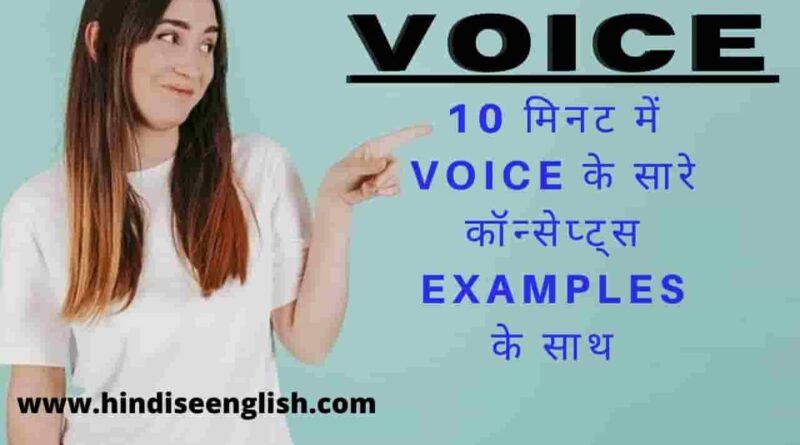Active And Passive Voice Rule: Exceptional Usage
Tense में हमलोगों ने जितने भी sentences पढ़े हैं उनमे से अधिकतर Active Voice में ही होते हैं,तो प्रश्न ये सामने आता है की फिर Passive Voice की आवश्यकता क्यों होती है? keyword of the day: active and passive voice rule
mainly हम Passive Voice का use तब करते हैं जब subject के comparision मैं object को अधीक importance दिया जाता है या हम किसी reason से subject (doer) को Highlight नहीं करना चाहते हैं।
- e.g. A.V. – Priya has eaten that mango
- P.V.- That mango has been eaten. Or, That mango has been eaten by Priya.
आप चाहें तो Passive Voice में subject (Priya) का mentin कर सकते हैं नहीं तो इसकी उतना ज्यादा importance नहीं है।
यहां हम exam के perspective से Voice का अध्ययन करेंगे अर्थात् हम इसे एक short trick की help से सीखेंगे।
उदाहरण के लिए, जब आप Active Voice के sentence में (V³) देखते हैं तो आपके mind में (been + v³) आना चाहिए, (V⁴) देखते हैं तो आपके mind में (being + v³) आना चाहिए, न की Active Voice के sentence के Whole Structure अर्थात् उसके tense check करने की बात आनी चाहिए। ऐसा करने से सिर्फ आपका समय व्यर्थ होगा और कुछ नहीं।No Doubts उसमें आपकी accuracy 100% होगी लेकिन selection से काफी पीछे रह जायेंगे। Previous Years की प्रश्नों की बात करें तो 90% से भी ज्यादा प्रश्न सिर्फ option से ही eliminate किए जा सकते हैं बशर्ते आपको इसके short trick के बारे में पता होना चाहिए।

short trick सीखने से पहले हम आगे प्रयोग होने वाले कुछ
Abbreviated form से परिचित होते हैं –
A.V. – Active Voice, P.V.– Passive Voice, D.O.– Direct Object, I.O.– Indirect Object
Voice-change करते समय subject को Object और Object को subject बनाया जाता है।
Subject-Object Formate
| subject | Object |
| I | Me |
| We | Us |
| He | Him |
| She | Her |
| It | It |
| They | Them |
| Ram | Ram |
| Who | (By) whom |
| One | XXX |
| People | XXX/People |
| What | (By) what or, what |
keyword of the day: active and passive voice rule
Basic Structure
Direct Object
Direct Object (D.O.) की पहचान : क्या का उत्तर
वाक्य से क्या लगाकर सवाल करने पर जो उत्तर हमें मिलता है ,Direct Object (D.O.) कहलाता है।
- e.g: He is writing a letter.
सवाल– क्या लिख रहा है?
जवाब – एक पत्र
यहां “letter” एक Direct Object है।
Indirect Object
Indirect Object (I.O.) : इस Object का प्रयोग व्यक्ति के लिए होता है।
Indirect Object की पहचान : किसको/किसे का उत्तर
वाक्य से किसको/किसे लगाकर सवाल करने पर जो उत्तर हमें मिलता है ,Indirect Object (I.O.) कहलाता है।
- e.g: He will offer me a job.
सवाल– क्या offer कर रहा है?
जवाब – a job
यहां “Job” एक Direct Object है।
सवाल– किसे offer कर रहा है?
जवाब – me (मुझे)
यहां “Me” एक Indirect Object है।
Verb of Perception
यह एक ऐसा verb है जिसे सिर्फ महसूस किया जा सकता है Physical Senses के द्वारा for e.g.- like,look, feel,watch,see,hear,listen,taste,smell,notice etc…
| Active Voice | Passive Voice |
| v¹/V5 (बिना HV का) या (do/ does … v¹) | (am/ is/ are + V³) |
| V2 (बिना HV का) या (did …, V1) | (was/ were + V³) |
| v³ | (been + v³) |
| v⁴ | (being + v³) |
| to + v¹ | (to be + v ³) |
| Modal + v¹ | (Modal + be + V3) |
| Modal + have + v³ | (Modal + have + been + v³) |
| v¹ + O | (Let + O + be + v³) |
| Let + I.O. + v¹ + D.O | (Let + D.O. + be + v³) |
keyword of the day: active and passive voice rule
Some Important facts and advanced structure
- Active Voice: S + like/likes + (to + V¹) + O…
Passive Voice : S + like/likes + O + ( to be + V³)
या, S + is/are + liked + (to be + V³) by + O
Ex — He likes to write a letter.
P.V — A letter is liked to be written by him.
Or, He likes a letter to be written. - Active Voice: S+need/ nèeds (to + V¹) +O…
Passive Voice: S+ need/ needs + (to be + V³)+ by +O..
या,S+ is/are + needed + (to be + V³) + by + O… Ex— He needs to learn the rules.
PV-The rules are needed to be learnt by him.
Or, The rules need to be learnt by him. - Active Voice: S (व्यक्ति)+ Verb of Perception+ I.O. (व्यक्ति) + (to +V)+ D.O (वस्तु)…
Passive Voice : S +Verb of Perception + D.O. + (to be + V3)+ by + I.O.
Ex — Women like their hubbies to do the household work.
PV-Women like the household work to be done by their hubbies. - AV: S (व्यक्ति)+ Verb of Perception +I.O. (व्यक्ति)+V⁴ +D.O (वस्तु)
PV: – S+ Verb of Perception +D.O. + (being+V3) + by+ I.O.
Ex — Women like their hubbies doing the household work.
PV– Women like the household work being done by their hubbies. - AV : वस्तु का नाम + tastes + वस्तु का स्वाद
PV : वस्तु का नाम + is + वस्तु का स्वाद + when (it is) tasted.
Ex – Mango tastes sweet.
PV – Mango is sweet when it’s tasted.
Or, Mango is sweet when tasted. - AV: Get yourself + V³…….
PV: be + V³
Ex – Get yourself prepared for the war.
PV – Be prepared for the war. - AV: Get someone + (to + V¹) + O ….
PV: have + O + V³ …. .
Ex – Get someone to break the car.
PV: Have the car broken. - AV: S + V¹/V⁵ + ‘that’- clause
PV : It is + V³ + + by + O + ‘that’- clause
Or, ‘that’- clause + is + V³ + by + O.
Ex – He says that they are shocked.
PV – It’s said by him that they are shocked.
Or, That they are shocked is said by him. - AV: S + V² + ‘that’- clause.
PV: – It was + V³ + by + O + ‘that’- clause.
Or, ‘That’ – Clause + was + V³ + by + O.
Ex – He said that they were shocked.
PV-It was said by him that they were shocked.
Or, That they were shocked was said by him. - Passive Voice में “Wh-word +S+HV …?” रहने पर उस option को छाँट दें।
Note: “Wh-word + HV+S…?” वाले option को चुनें। - Passive Voice में by one नहीं होता है
- Passive Voice में generally by people नहीं होता है कुछ cases में हो भी सकता है।
- Passive Voice में Subject के रूप में Anyone/ Anybody के बाद not का प्रयोग कभी नहीं होता है।
Note: ऐसी स्थिति में Passive Voice में None/ No one/ Nobody का प्रयोग Subject के रूप में करें। - Passive Voice में Subject के रूप में Anything के बाद not का प्रयोग कभी नहीं होता है।
Note: ऐसी स्थिति में Passive Voice में Nothing का प्रयोग Subject के रूप में करें। - Passive Voice में (to not + V¹.) को छाँट दें।
Note: (not to + V¹) को चुनें। - Passive Voice में Please रहने पर उस Option को छाँट दें।
Note: V³, के रूप में requested वाले Option को चुनें। - Passive Voice में forbidden के साथ not रहने पर उस Option को छाँट दें।
- Passive Voice में known by रहने पर उस Option को छाँट दें।
Note: known to वाले Option को चुनें।
Ex – He knows me.
PV – I am known to him. - Passive Voice में (hurt by + something) रहने पर उस Option को छाँट दें।
Note: (hurt at + something) वाले Option को चुनें।
Ex – (i) She hurt my heart.
PV – My heart was hurt by her (व्यक्ति).
(ii) Her bad behaviour hurt my heart.
PV – My heart was hurt at her bad behaviour. - Passive Voice में (contained/ interested/ etc. + by) रहने पर उस Option को छाँट दें।
Note: ऐसे V³ के ठीक बाद in प्रयोग करें।
Ex – (i) This book contains 150 pages.
PV-150 pages are contained in this book.
ii) English interests me.
PV – I am interested in English. - Passive Voice में displeased + by+ something) रहने पर उस Option को छाँट दें।
Note: ऐसे V³ के ठीक बाद at प्रयोग करें।
Ex – Her bad behaviour displeased me.
PV – I was displeased at her bad behaviour. - Passive Voice में (ashamed/ afraid/deprived/ etc. + by+ something) रहने पर उस Option को छाँट दें।
Note: ऐसे V³ के ठीक बाद of प्रयोग करें।
Ex – The spectre afrays a timid person.
PV – A timid person is afraid of the spectre. - Passive Voice में pleased by रहने पर उस Option को छाँट दें।
Note: pleased with वाले Option को चुनें।
Ex – Her good behaviour pleased me.
PV- I was pleased with her good behaviour. - यदि Passive Voice में तीन Options प्रामाणिक रूप से गलत हो एवं एक Option का Voice सही हो, किन्तु (by + O) न हो, तो भी उसे ही चुनना होगा।
- यदि Active Voice में Verb के ठीक बाद Prep.हो, तो Passive Voice में Verb के ठीक बाद दो Prep. लगातार होगा।
* (… V3 + सवाल का Prep. + by+O)
Ex–He looked at me.
PV-I was looked at by him. - यदि Active Voice, HV से शुरू हो, Passive Voice भी HV से शुरू होगा।
- यदि Passive Voice में Unwanted Words दिया रहे तो उसे छाँट दें।
- सवाल का कोई विशेष शब्द या शब्द-समूह यदि किसी Option से लुप्त हो, तो उस Option को छाँट दें।
- AV: It is time + to + V¹ + O.
PV: – It is time + for + O + to + be + V3.
Ex – It is time to water the plants.
PV – It is time for the plants to be watered. - Active Voice में दो Object यदि दिया रहे एवं Passive Voice में वस्तु वाले Object को Subject बनाया जाये, तो व्यक्ति वाले Object को ‘V³ + O’ के ठीक बाद to + I.O (व्यक्ति) को लिखा जाता है।
PV: – S (वस्तु) + HV + V³ + to + I.O.(व्यक्ति) + by +O.
Or, S (व्यक्ति) + HV + V³ + D.O. (वस्तु) + by + O.
Ex – I gave him a gift.
PV – He was given a gift by me.
Or, A gift was given to him by me. - जव We का प्रयोग समस्त मानव-जाति के लिए हो या एक दश के समस्त नागरिकों के लिए हो, Passive Voice में by us’ का प्रयोग नहीं होता हैं।
- यदि Active Voice के Verb को Passive Voice में Noun या V बनाकर मिनट में VOICE के सारे कॉन्सेप्ट्स EXAMPLES के साथदिया रहे, तो उसे छाँट दें।
Thanks for reading:active and passive voice rule
Read also:
All about *to* preposition, List Of Root Word, Hindi Se English Stories, Common Doubts Of Grammar, Topic Wise Word List
